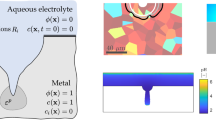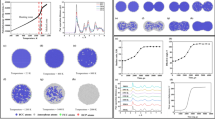Abstract
A model for simultaneous and coupled diffusion and precipitation of chemical elements in metallic matrices is proposed, together with a scheme for its numerical solution and some applications to problems of internal oxidation. This model extends over a previous one of the authors, which itself stood as a generalization of many earlier ones. It includes the possibility that precipitates may be present in large fractions; if so, they may affect diffusion in the matrix phase by acting as “barriers”, and/or by distorting this matrix. The possible re-dissolution of some or all precipitates may also be prohibited for kinetic reasons. A simple but robust numerical scheme based on 1D finite differences in space coupled with explicit integration in time is proposed to solve the equations of the problem. This scheme notably contains an efficient Newton–Raphson algorithm used to solve the laws of mass action. Numerical simulations of internal oxidation processes close to those encountered in actual industrial practice are finally presented. It is first shown that in simple cases, the simulations reproduce Wagner’s classical analytical solution and related ones. More complex cases not amenable to analytic solutions are then envisaged.










Similar content being viewed by others
Notes
This formula disregards the small elastic deformations which arise from the internal stresses generated by the expansion.
Note also that unlike analytical approaches, the numerical method developed here would in principle perfectly allow to account for boundary conditions varying in time. The only reason for not doing so lies in the lack of accurate experimental data on kinetics of surface reactions.
This distribution is truly discontinuous only in Wagner’s solution, because the solubility product of the precipitate is considered to be zero. In numerical simulations this solubility product is small but not strictly zero, so that the total fraction of the oxidized element varies quickly over some small distance but nevertheless continuously.
The contrary would mean violation of the hypothesis of dilute solution, and was observed in none of the simulations.
In contrast, the balance law of possible “minor” elements present in none of the major precipitates is affected by the presence or absence of this corrective factor. But this is unimportant, because the diffusion of these elements has no influence whatsoever on that of major ones since they do not interact through chemical combinations in major precipitates.
This phenomenon was already apparent in Wagner’s solution, even though it did not include any reduction of diffusion coefficients by precipitation.
One should not confuse the fraction of Al2O3 and the total fraction of aluminum; in the present case, in Wagner’s solution, the first fraction exceeds 1,000,000 ppm but the second does not.
References
J. M. Bergheau, J. Devaux, P. Duranton, R. Fortunier, B. Larreur, and J. B. Leblond, Surface Treatment VI - Computer Methods and Experimental Measurements for Surface Treatment Effects, eds. C. Brebbia, J. T. M. de Hosson, and S.-I. Nishida (WIT Press, Southampton, 2003), p. 297.
K. Bongartz, D. F. Lupton, and H. Schuster, Metallurgical Transactions A 11, 1883 (1980).
H. J. Christ, H. G. Sockel, and W. Christl, Werkstoffe und Korrosion 37, 385 (1986) (in German).
D. L. Douglass, Oxidation of Metals 44, 81 (1995).
A. Engstorm, L. Hoglund, and J. Agren J, Metallurgical and Materials Transactions A 25, 1127 (1994).
G. Eriksson, P. Wu, M. Blander, and A. D. Pelton, Canadian Metallurgical Quarterly 33, 13 (1994).
R. Fortunier, J. B. Leblond, and D. Pont, Phase Transformations During the Thermal/Mechanical Processing of Steel, eds. E. B Hawbolt and S. Yue (the Canadian Institute of Mining, Metallurgy and Petroleum, Montreal, 1995), p. 357.
R. Fortunier, J. B. Leblond, and J. M. Bergheau, Journal of Shanghai Jiaotong University 5, 303 (2000).
F. Gesmundo and B. Gleeson, Oxidation of Metals 44, 211 (1995).
F. Gesmundo and Y. Niu, Oxidation of Metals 51, 129 (1999).
F. Gesmundo, F. Viani, and Y. Niu, Oxidation of Metals 45, 51 (1996).
F. Gesmundo, F. Viani F, and Y. Niu, Oxidation of Metals 47, 355 (1997).
F. Gesmundo, P. Castello, F. Viani, and C. Roos C, Oxidation of Metals 49, 237 (1998).
D. Huin, V. Lanteri, D. Loison, P. Autesserre, and H. Gaye, in Microscopy of Oxidation, eds S. B. Newcomb and J. A. Little, Vol. 3 (the Institute of Metals, London, 1997), p. 573.
D. Huin, P. Flauder, and J. B. Leblond, Oxidation of Metals 64, 131 (2005).
J. S. Kirkaldy, Canadian Metallurgical Quarterly 8, 35 (1969).
J. S. Kirkaldy, in Oxidation of Metals and Alloys, ed D. L. Douglass (American Society of Metals, Metals Park, 1971) p. 101.
G. Laflamme and J. E. Morral, Acta Metallica, 26, 1791 (1978).
J. B. Leblond, Journal of Nonlinear Analysis Part B: Real World Applications 6, 297 (2005).
D. Loison, D. Huin, V. Lanteri, J. P. Servais, and R. Cremer, Proceedings of the 5th International Conference on Zinc and Zinc Alloy Coated Steel Sheet (GALVATECH’2001), Brussels, June 2001, pp. 203 (2001).
Y. Niu and F. Gesmundo, Oxidation of Metals 56, 517 (2001).
H. Oikawa, Transactions of the Iron and Steel Institute of Japan 68, 1489 (1982).
E. K. Ohriner and J. E. Morral, Scripta Metallica 13, 7 (1979).
R. Rapp, Corrosion 21, 382 (1965).
E. Rank and U. Weinert, IEEE Transactions on Computer-Aided Design of Integrated. Circuits and Systems 9, 543 (1990).
F. H. Stott and G. C. Wood, Materials Science and Technology, 4, 1072 (1988).
Thermodata. Electronic data bank for thermodynamic quantities, available online at the address http://thermodata.online.fr (2005).
C. Wagner, Zeitschrift fur Elektrochemie 63, 772 (1959) (in German).
D. P. Whittle, F. Gesmundo, B. D. Bastow, and G. C. Wood, Oxidation of Metals 16, 159 (1981).
Acknowledgement
The authors wish to express their sincere thanks to François Mudry for his moral and financial support.
Author information
Authors and Affiliations
Corresponding author
Appendices
Appendix 1: Diffusion and Precipitation Data
The atomic masses (in g mol−1) of O, Al, Mn and Si and their diffusion coefficients (in μm2 s−1) in pure iron are provided by the following formulae, where the absolute temperature T is in K:
Expressions (16)5,6,7,8 for the D 0 i here are taken from the work of Oikawa [22].
The molecular masses (in g mol−1) of Al2O3, MnO, SiO2 and Mn2SiO4, their solubility products (in ppmn where n is the total number of atoms in the molecule), and their specific volumes (in cm3 g−1) together with that of pure iron, are given by
Formulae (17)5,6,7,8 for the K α are taken from the Thermodata [27] electronic bank, except that for K Mn 2SiO4 which was adjusted using experimental data provided by Eriksson et al. [6].
Appendix 2: Dependence of the Solution Upon the Sole Variable \(x/ \sqrt{t}\)
In order to prove that the solution of a given 1D diffusion problem depends on the sole variable
one must rewrite the equations of this problem with this assumption, and check that no contradiction then arises; this means that all quantities appearing in the new equations must depend on u alone.
Initial Model
We first study the case of the “initial” model which includes neither the reduction of diffusion coefficients in Eq. 3 nor the dilation of coordinates in Eq. 5, and considers re-dissolution of precipitates as possible. We assume all quantities F T i and F D i (i = 1, 2,…n e ) and P α (α = 1, 2,…n p ) to be functions of the sole variable u. This does not raise any problem in the balance Eq. 1, nor in the laws of mass action (6) (with the “ALLOW” option). Also, Eqs. 2 take the form
and there is again no problem since all quantities here depend only on u. The boundary conditions discussed in the section on “Treatment of Boundary Conditions” read
and the initial conditions read
These conditions are non-contradictory (note that Eq. 21 1,2 duplicate Eq. 20 2), and again involve the sole variable u. Thus all equations of the problem are compatible with a solution depending only on the variable u.
Model with Reduction of Diffusion Coefficients
The introduction of the possible reduction of diffusion coefficients by precipitation (Eq. 3) modifies only Eqs. 2. Let ϕ(u) denote the ratio in the right-hand side of Eq. 3. (This is a function of u alone since the P α (α = 1, 2,…n p ) are assumed to depend on this sole variable). The diffusion equations then take the form
which is again compatible with the assumption that the solution depends only on u.
Model with Dilation of Coordinates
When the possible dilation of coordinates by precipitation (Eq. 5) is accounted for, one must distinguish between the initial coordinate, x 0, and the present one, x. We then define the variable u as
Again, the dilation of coordinates modifies only Eqs. 2. By Eq. 5,
where ϕ(u) is the same function as before. Therefore the diffusion equations take the form
(where the dot denotes the material time-derivative, that is the partial differentiation with respect to t at constant x 0), or equivalently
This equation is again compatible with the assumption that the solution depends only on u.
Model with Prohibition of Re-Dissolution of Precipitates
We finally consider the model where possible re-dissolution of precipitates is prohibited. This prohibition only modifies the laws of mass action (6), where the option “FORBID” must now be considered. Then the conditions P α = 0 in Eq. 6 1 and P α > 0 in Eq. 6 3 must be replaced by \(\dot{P}_{\alpha}=0,\) \(\dot{P}_{\alpha}>0.\) But if P α depends only on u, these conditions may be written in the form \(\frac{dP_{\alpha}}{du}(u)=0,\) \(\frac{dP_{\alpha}} {du}(u)<0.\) Hence the laws of mass action may again be written in a form involving the sole variable u, which again shows that the solution depends on this sole variable.
Rights and permissions
About this article
Cite this article
Brunac, JB., Huin, D. & Leblond, JB. Numerical Implementation and Application of an Extended Model for Diffusion and Precipitation of Chemical Elements in Metallic Matrices. Oxid Met 73, 565–589 (2010). https://doi.org/10.1007/s11085-010-9193-7
Received:
Revised:
Published:
Issue Date:
DOI: https://doi.org/10.1007/s11085-010-9193-7




